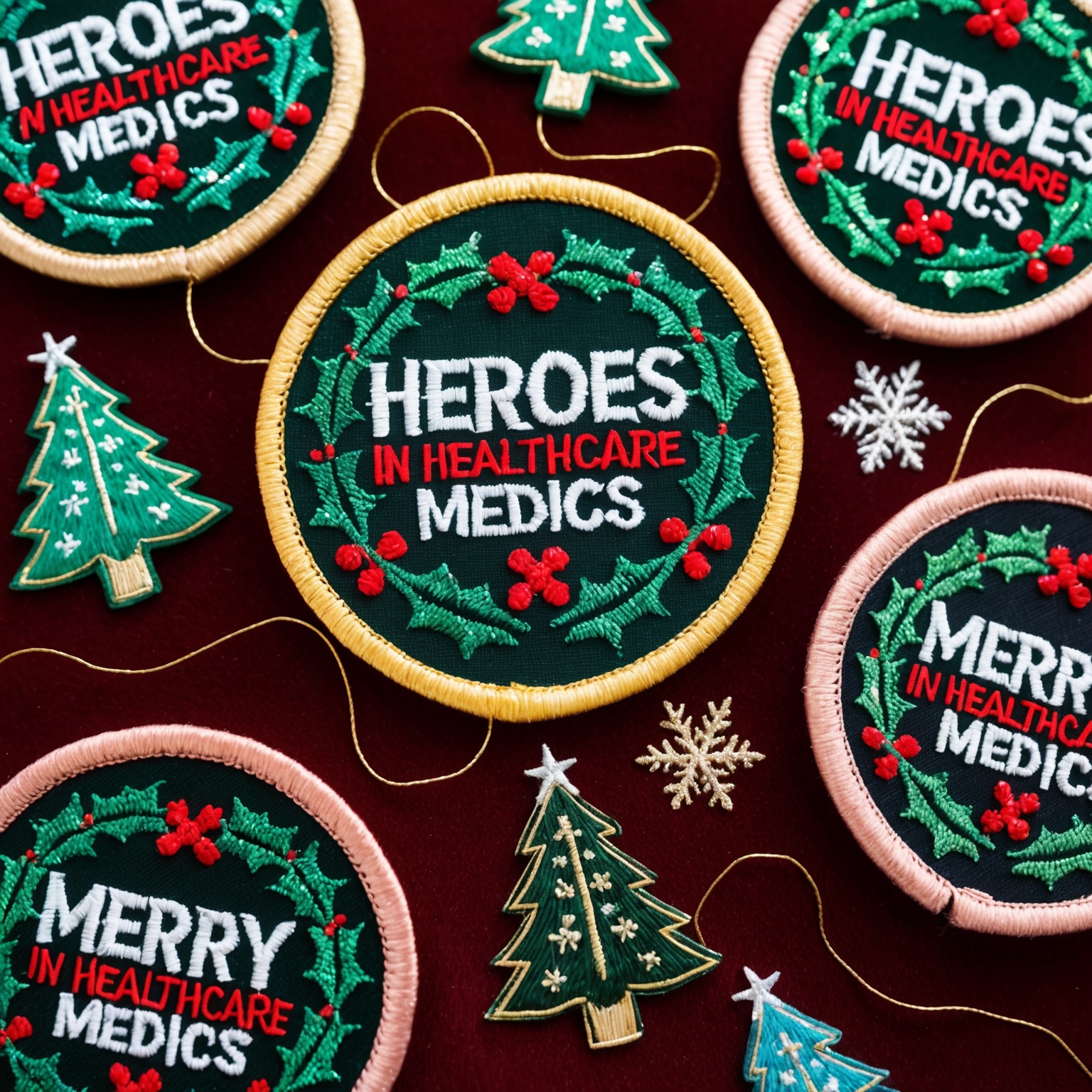Custom patches are a popular way for aviation students to showcase their school spirit, achievements, and affiliations. These patches are not just pieces of fabric; they are symbols of pride, unity, and identity. Designing custom patches that accurately reflect the spirit of your aviation school involves creativity, attention to detail, and an understanding of the elements that make a patch truly memorable. This article will guide aviation students through the process of designing custom patches, from conceptualization to production, ensuring that the final product embodies their school spirit.
Aviation schools are known for their rigorous training programs, strong sense of community, and deep-rooted traditions. Custom patches provide a unique way for students to express their pride and affiliation with their school. Whether worn on uniforms, flight jackets, or backpacks, these patches serve as constant reminders of the hard work, dedication, and camaraderie that define the aviation school experience.
Designing custom patches that reflect your school spirit involves more than just choosing colors and images. It requires a thoughtful approach to ensure that the patch represents the values, history, and aspirations of your aviation school. This article will explore the steps involved in creating custom patches, from initial concept to final production, offering practical tips and insights along the way.
The Importance of Custom Patches in Aviation Schools
Building School Spirit
Custom patches play a significant role in building school spirit. They serve as visual representations of the pride and loyalty students feel towards their aviation school. Wearing a patch that embodies the school’s identity fosters a sense of unity and belonging among students.
Recognizing Achievements
Custom patches can be designed to recognize various achievements, such as completing flight training milestones, academic excellence, participation in aviation clubs, and community service. These patches serve as tangible symbols of students’ hard work and dedication.
Promoting School Identity
Patches help promote the identity of the aviation school. They can incorporate the school’s logo, colors, and symbols, making them instantly recognizable. When students wear these patches, they become ambassadors for their school, showcasing its values and traditions.
Fostering Camaraderie
Custom patches foster camaraderie among students. When everyone wears patches that represent their school or specific achievements, it creates a shared identity and strengthens the bonds within the community. This sense of unity is especially important in aviation schools, where teamwork and collaboration are essential.
Steps to Designing Custom Patches
Step 1: Define the Purpose
Before starting the design process, it’s essential to define the purpose of the custom patch. Consider the following questions:
- What is the primary goal of the patch? Is it to recognize an achievement, commemorate an event, or promote school spirit?
- Who is the target audience? Are the patches for students, faculty, alumni, or specific groups within the school?
- What message do you want to convey? Think about the values, history, and identity of your aviation school that you want the patch to reflect.
Step 2: Gather Inspiration
Gathering inspiration is a crucial step in the design process. Look at existing patches from your aviation school and other institutions to get ideas. Consider the following sources of inspiration:
- School History and Traditions: Incorporate elements from your school’s history and traditions, such as founding dates, mottos, and iconic symbols.
- Aviation Themes: Use imagery related to aviation, such as aircraft, wings, propellers, and navigation tools.
- Local Culture and Landmarks: Reflect the local culture and landmarks of your school’s location to add a unique touch.
- Achievements and Milestones: Highlight specific achievements and milestones, such as flight hours, licenses, and awards.
Step 3: Sketch Initial Designs
Once you have gathered inspiration, start sketching initial designs. This step allows you to explore different ideas and layouts before finalizing the design. Consider the following tips for sketching:
- Create Multiple Drafts: Sketch several different designs to explore various concepts and layouts.
- Focus on Key Elements: Identify the key elements that must be included, such as the school’s logo, colors, and symbols.
- Experiment with Shapes and Sizes: Try different shapes and sizes to see which works best for your design.
Step 4: Refine the Design
After sketching initial designs, choose the best concepts and refine them. This step involves adding details, adjusting proportions, and finalizing the layout. Consider the following tips for refining the design:
- Add Details: Incorporate fine details that enhance the design, such as intricate patterns, shading, and highlights.
- Balance the Elements: Ensure that all design elements are balanced and harmoniously arranged.
- Use Digital Tools: Use digital design tools to create clean and precise designs. Software such as Adobe Illustrator and CorelDRAW are excellent for creating vector graphics.
Step 5: Choose Colors
Choosing the right colors is essential for creating an eye-catching and meaningful patch. Consider the following tips for selecting colors:
- School Colors: Use your school’s official colors to maintain consistency with other branding materials.
- Contrast and Visibility: Ensure that the colors chosen provide good contrast and visibility, making the design elements stand out clearly.
- Symbolic Colors: Select colors that have symbolic meaning. For example, blue can represent trust and loyalty, while red can signify courage and determination.
Step 6: Select Materials and Production Techniques
The choice of materials and production techniques can significantly impact the final look and feel of the custom patch. Consider the following options:
- Embroidery: Embroidered patches offer a classic and durable option. High-thread-count embroidery allows for detailed designs and vibrant colors.
- Woven Patches: Woven patches are ideal for intricate designs with fine details. They provide a smooth and professional finish.
- PVC Patches: PVC patches are durable and weather-resistant, making them suitable for outdoor activities and uniforms. They offer a modern look and can be produced in various shapes and colors.
- Backing Options: Choose appropriate backing options, such as iron-on, sew-on, or Velcro, based on the intended use of the patches. Velcro backings allow for easy attachment and removal, making them versatile for different applications.
Step 7: Collaborate and Seek Feedback
Collaborating with others and seeking feedback is crucial for ensuring that the design meets the expectations of the target audience. Consider the following tips for collaboration and feedback:
- Involve Stakeholders: Involve students, faculty, and alumni in the design process to gather diverse perspectives and ideas.
- Conduct Surveys: Use surveys to gather feedback on different design concepts and make informed decisions.
- Hold Design Workshops: Organize design workshops where participants can share their ideas and collaborate on the final design.
Step 8: Finalize the Design and Produce the Patches
Once the design is refined and approved, it’s time to finalize the design and produce the patches. Consider the following tips for finalizing and producing the patches:
- Finalize the Design: Ensure that the design is clean, precise, and ready for production. Make any necessary adjustments based on feedback.
- Choose a Reputable Manufacturer: Select a reputable manufacturer with experience in producing high-quality custom patches. Research potential manufacturers, review their portfolios, and request samples to evaluate their work.
- Place the Order: Place the order with the chosen manufacturer and provide clear instructions regarding the design, materials, and production techniques.
- Quality Control: Review the final patches to ensure they meet the desired quality standards. Address any issues with the manufacturer if necessary.
Case Studies: Successful Custom Patches in Aviation Schools
Case Study 1: Embry-Riddle Aeronautical University
Background
Embry-Riddle Aeronautical University, one of the leading aviation schools globally, has effectively used custom patches to boost school spirit and recognition.
Implementation
Embry-Riddle designs and awards custom patches for various achievements, including academic excellence, flight training milestones, and participation in aviation clubs. The patches feature the university’s logo, colors, and relevant symbols, creating a strong sense of identity and pride among students and staff.
Impact
The custom patches have significantly enhanced school spirit at Embry-Riddle. Students proudly display their patches on uniforms and personal items, fostering a sense of community and motivation to excel. The patches also serve as powerful marketing tools, promoting the university’s brand and reputation.
Case Study 2: Vaughn College of Aeronautics and Technology
Background
Vaughn College of Aeronautics and Technology, known for its comprehensive aviation programs, has successfully implemented custom patches to recognize student achievements and build school spirit.
Implementation
Vaughn College awards custom patches for various milestones, such as solo flights, pilot licenses, and academic honors. The patches incorporate the college’s logo, aviation symbols, and personalized elements, creating a unique and meaningful form of recognition.
Impact
The custom patches have enhanced student motivation and engagement at Vaughn College. Students value the tangible recognition of their achievements and take pride in wearing their patches. The patches also contribute to a strong sense of community and belonging within the college.
Case Study 3: Purdue University School of Aviation and Transportation Technology
Background
Purdue University School of Aviation and Transportation Technology has leveraged custom patches to celebrate student achievements and promote school spirit.
Implementation
Purdue University designs and awards custom patches for various achievements, including academic excellence, flight training milestones, and participation in aviation-related activities. The patches feature the university’s logo, colors, and relevant symbols, reinforcing the school’s identity and values.
Impact
The custom patches have had a positive impact on student morale and motivation at Purdue University. Students appreciate the recognition of their hard work and proudly display their patches. The patches also serve as effective marketing tools, enhancing the university’s visibility and reputation.
Practical Tips for Designing Custom Patches
Keep It Simple
While it’s tempting to include numerous details in the patch design, simplicity often works best. A clean, straightforward design ensures that all elements are easily recognizable and that the patch is visually appealing.
Ensure Legibility
Make sure that any text included in the design is legible. Choose fonts that are easy to read and avoid overcrowding the patch with too much text. The key information should be clear and visible from a distance.
Test Different Color Combinations
Experiment with different color combinations to find the most effective and visually appealing options. Consider how the colors will look when embroidered or printed, and ensure that they complement each other.
Consider the Patch’s Placement
Think about where the patch will be placed, such as on a uniform, jacket, or backpack. The size and shape of the patch should be appropriate for its intended placement, and the design should be easily recognizable from a distance.
Plan for Scalability
Design the patch so that it can be easily scaled to different sizes without losing its integrity. This ensures that the patch can be used in various applications, from small lapel pins to larger jacket patches.
Conclusion
Custom patches are a powerful tool for aviation students to express their school spirit, recognize achievements, and foster a sense of community. By following a strategic approach to design and production, aviation schools can create patches that accurately reflect their identity and values.
From defining the purpose of the patch to gathering inspiration, refining the design, and collaborating with stakeholders, each step in the process is crucial for creating a meaningful and visually appealing patch. The successful implementation of custom patches in aviation schools like Embry-Riddle Aeronautical University, Vaughn College of Aeronautics and Technology, and Purdue University demonstrates the positive impact these patches can have on student motivation, school spirit, and community engagement.
By embracing the potential of custom patches, aviation schools can enhance their branding, promote their values, and celebrate the achievements of their students and staff. These patches serve as lasting symbols of pride, unity, and dedication, inspiring the next generation of aviation professionals to reach new heights.
If you are interested in purchasing high-quality custom patches, feel free to call us at 1-866-903-4903 or fill out one of our FREE quotes here.




